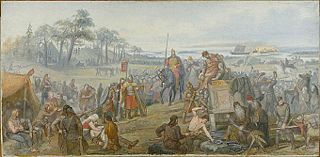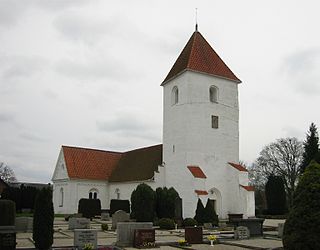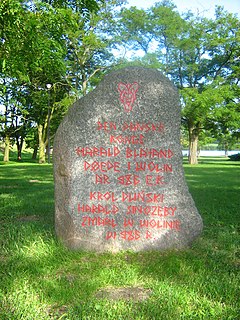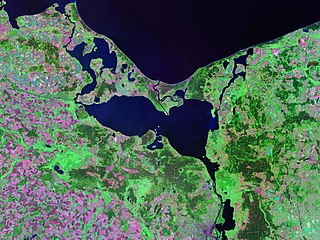 W
WThe Jomsvikings were an order of Viking mercenaries or conquerors of the 10th century and 11th century. They were staunchly Pagan and dedicated to the worship of such deities as Odin and Thor. They reputedly would fight for any lord able to pay their substantial fees and occasionally fought alongside Christian rulers. Although they were Pagan, the institutions of the Jomsvikings in some ways foreshadowed those of the Christian Knightly Orders of the later Middle Ages.
 W
WThe Battle of Fýrisvellir was a battle for the throne of Sweden which was fought in the 980s on the plain called Fýrisvellir, where modern Uppsala is situated, between King Eric the Victorious and his nephew Styrbjörn the Strong. It is mentioned in a number of medieval sources, such as Eyrbyggja saga, Knýtlinga saga, Hervarar saga and Saxo Grammaticus' Gesta Danorum, but the most detailed account is found in the short story Styrbjarnar þáttr Svíakappa.
 W
WThe Battle of Hjörungavágr is a semi-legendary naval battle that took place in the late 10th century between the Jarls of Lade and a Danish invasion fleet led by the fabled Jomsvikings. This battle played an important role in the struggle by Haakon Sigurdsson to unite his rule over Norway. Traditionally, the battle has been set during the year 986.
 W
WThe Battle of Svolder was a naval battle fought in September 999 or 1000 in the western Baltic Sea between King Olaf Tryggvason of Norway and an alliance of his enemies. The backdrop of the battle was the unification of Norway into a single state, long-standing Danish efforts to gain control of the country, and the spread of Christianity in Scandinavia.
 W
WThe Curmsun Disc is a concave gold disc of a weight of 25.23 grams (0.890 oz) and a diameter of 4.5 centimetres (1.8 in). The Danish Viking king Harald Bluetooth is mentioned in the inscription of the disc. The disc's characteristics are typical of Ottonian Art.
 W
WThe Hällestad Runestones are three runestones located in the walls of Hällestad Church in Torna-Hällestad, about 20 kilometers east of Lund in Skåne, southern Sweden. Their Rundata identifiers are DR 295, 296, and 297. DR 295 is notable because it is held to be raised in memory of a warrior who fell in the legendary Battle of the Fýrisvellir, near Uppsala, Sweden between the Jomsvikings led by Styrbjörn the Strong and Styrbjörn's uncle Eric the Victorious, the king of Sweden, c. 985. The other stones were raised by the same people, and they probably formed a monument together in memory of comrades lost in the battle.
 W
WJomsborg or Jómsborg was a semi-legendary Viking stronghold at the southern coast of the Baltic Sea, that existed between the 960s and 1043. Its inhabitants were known as Jomsvikings. Jomsborg's exact location, or its existence, has not yet been established, though it is often maintained that Jomsborg was somewhere on the islands of the Oder estuary. Lauritz Weibull dismissed it as a legend.
 W
WThe Jómsvíkinga saga (Saga of the Jomsvikings) is a medieval Icelandic saga composed by an anonymous Icelander. The Saga was composed in Iceland during the 13th century. It exists in several manuscripts which vary from each other. There are many different versions and translations of the saga.
 W
WPalnatoke or Palnatoki, sometimes written Palna-Toki or Palna Toki, was a legendary Danish hero and chieftain of the island of Fyn. According to the Jómsvíkinga saga, Palnatoki founded the brotherhood of Jomsvikings and established its laws.
 W
WThe history of Pomerania starts shortly before 1000 AD with ongoing conquests by newly arrived Polans rulers. Before that the area was recorded nearly 2000 years ago as Germania, and in modern-day times Pomerania is split between Germany and Poland. The name Pomerania comes from the Slavic po more, which means Land at the Sea.
 W
WPomerania during the Early Middle Ages covers the History of Pomerania from the 7th to the 11th centuries.
 W
WJarl Sigvaldi was the semi-legendary chieftain of the fabled Jomsvikings and commander of their stronghold - Jomsborg. He succeeded Palnatoke as the leaders of the Jomsvikings in the late 10th century. The character of Sigvaldi remains largely enigmatic. As a leader, he was said to be more wily than brave despite leading such a powerful force.
 W
WThe Sjörup Runestone is a runestone in Scania, Sweden, from approximately 1000 AD that is classified as being in runestone style RAK.
 W
WStyrbjarnar þáttr Svíakappa is a short story, a þáttr on the Swedish claimant and Jomsviking Styrbjörn the Strong preserved in the Flatey Book.
 W
WStyrbjörn the Strong according to late Norse sagas was a son of the Swedish king Olof, and a nephew of Olof's co-ruler and successor Eric the Victorious, who defeated and killed Styrbjörn at the Battle of Fyrisvellir. As with many figures in the sagas, doubts have been cast on his existence, but he is mentioned in a roughly contemporaneous skaldic poem about the battle. According to legend, his original name was Björn, and Styr-, which was added when he had grown up, was an epithet meaning that he was restless, controversially forceful and violent.
 W
WThorkell the Tall, also known as Thorkell the High in the Anglo-Saxon Chronicle, was a prominent member of the Jomsviking order and a notable lord. He was a son of the Scanian chieftain Strut-Harald, and a brother of Jarl Sigvaldi, Hemingr and Tófa. Thorkell was the chief commander of the Jomvikings and the legendary stronghold Jomsborg, on the Island of Wollin. He is also credited as having received the young Cnut the Great into his care and taken Cnut on raids. The Encomium Emmae, a document aimed at the movers and shakers of the Anglo-Scandinavian court in the early 1040s, describes Thorkell as a great war leader and warrior.
 W
WVagn Åkesson was a Norseman of the late 10th century, mentioned in the Jómsvíkinga saga. At the age of 12, Vagn, a precocious warrior, applied for admission to the mercenary brotherhood of the Jomsvikings. According to the Jómsvíkinga saga, Vagn was the son of Aki, a son of the Jomsviking chieftain Palnatoke. Intrigued by the courage displayed by Vagn, his grandfather Palnatoke allowed him to prove his worth with a duel against Sigvaldi Strut-Haraldsson, whom Vagn defeated. He was admitted to the order despite the Jomsviking rule that no man under the age of 18 be allowed to join.
 W
WWolin is the name both of a Polish island in the Baltic Sea, just off the Polish coast, and a town on that island. Administratively the island belongs to the West Pomeranian Voivodeship. Wolin is separated from the island of Usedom (Uznam) by the Strait of Świna, and from mainland Pomerania by the Strait of Dziwna. The island has an area of 265 km2 (102 sq mi) and its highest point is Mount Grzywacz at 116 m above sea level. The number of inhabitants is 30,000.